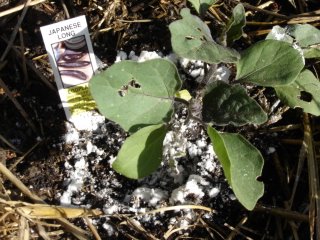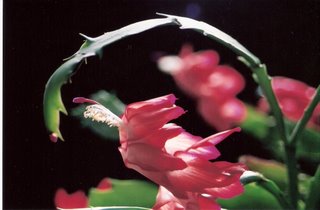Saturday, May 20, 2006
Solarizing: the sequel
I will now quote from my well-worn Rodale's Garden Problem Solver. (be sure and read this to the end about solarizing's effect on beneficial organisms)
"Solarization was developed in Israel and has been tested at a number of universities across this country. It is a process that produces very high levels of heat and humidity in the soil, which pasteurizes the soil, destroying harmful bacteria, fungi, some nematodes, virtually every type of insect larva, and the stock of weed seeds near the surface.
Solarization has been found to be an effective control against such pesky disease problems as verticillium wilt in tomatoes, potates, and eggplants. It knocks out fusarium wilt in tomatoes and onions. It is effective against rhizoctonia in potatoes and onions, and eliminates a variety of nematodes that attack potatoes and other crops.
An unexpected and unexplained benefit of solarization is that it also enhances the soil's ability to grow especially robust and healthy plants. Greater yields have been seen in beds that have been solarized. Solarization destroys harmful organisms, but it seems that certain beneficial organisms are not harmed.
Jim DeVay, chairman of the plant pathology department at the University of California at Davis, is quoted as saying: "While many fungi, bacteria and other pathogens are killed, certain fungi that play an important role in utilization of plant nutrients and crop development withstand the heat and survive."
See my updated post "Solarizing and Vinegar: organic weed control" for 'How-to' instructions.
Wednesday, May 17, 2006
Solarizing and Vinegar: organic weed control
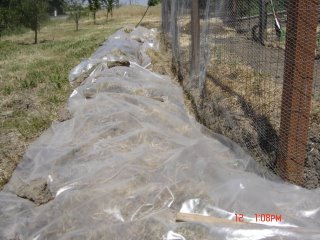 For weed control nothing beats solarizing. It's cheap--$12-13 for a 4' x 50' roll. It's easy, organic and it definitely works!
For weed control nothing beats solarizing. It's cheap--$12-13 for a 4' x 50' roll. It's easy, organic and it definitely works!We have lots of bermuda and foxtail grass and I have begun solarizing in earnest this year to help keep things better until control.
For small, spot weed control, full strenth vinegar works as good as RoundUp. This works on tender leafed plants. I keep a spray bottle handy. Works good around rocks, brick pathways, etc. For serious weed control go to Solarization.
To try solarizing:
- Buy 4' x 50' rolls of CLEAR medium to heavy plastic (3-6 mil) at the hardware store. Anything larger is too cumbersome to work with.
- Thoroughly wet the area you want to rid of weeds, harmful bacteria, insect larva, etc. The deeper the ground is soaked the better.
- If you want to take the extra step of loosening up the soil, this is recommended, although I have not tried this yet.
- Unroll the plastic and lay it out flat. It's handy to have an extra person (if you can find one).
- Lay it on the area you want to solarize.
- Put something around the edges to hold it down. Anything handy, but the more you 'seal' the edges the better it works. I use old garden 2x2's from past tomato cages, etc.
- Go do something else for a week or until everything looks really dead under there. The more sun the area gets, the better. If you slide your hand under the plastic after a day or so, you can feel how hot it is under there.
- For thorough pasteurization of the soil, you can leave it on for 4-6 weeks. The best time to solarize soil is in the hot summer months of course. If it rains during this time, simply sweep off the puddles. Don't punch holes in plastic.
Monday, May 15, 2006
Heirlooms: not your 6-pack of Celebrities
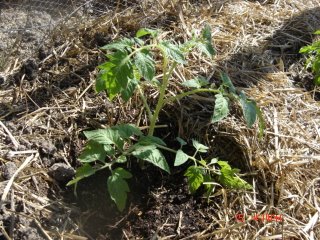 Usually I get whatever looks the healthiest at the nursery, but there's nothing except Celebrities, Early Girls, Beefsteak...the usual. We don't have a real nursery in this town---the kind that germinates and grows their own starts. However I always have an overbundance of really good tomatoes, so I don't complain.
Usually I get whatever looks the healthiest at the nursery, but there's nothing except Celebrities, Early Girls, Beefsteak...the usual. We don't have a real nursery in this town---the kind that germinates and grows their own starts. However I always have an overbundance of really good tomatoes, so I don't complain.But yesterday someone gave me 5 heirloom tomatoes!.....over flow from their community garden I think. It makes me feel like I've 'graduated'to a whole new level of gardening.
Being a gift also made it more special; and I think it's so cool to have a tomato with a name like 'Marianna's Peace'. You just know that this plant has a neat history. The little plant stick says it's from Bohemia Czechoslovakia and came over after WWII.
Another one called "Dixie Golden Giant" has been grown by an Amish family since 1930. It has lemon-yellow beefsteak type tomatoes, few seeds and pink blossoms!
Knowing just a little bit of the origin of these plants makes me feel connected to another time and place....and real people who tended these plants and passed them on. Not a feeling I get with a 6 pack of Celebrities.
There's a Reisentraub which apparently translates as "Giant Bunch of Grapes" and its a cherry tomato plant.
Then there's something called Big Rainbow which has large yellow and/or golden orange and/or ruby red fruit. That's pretty awesome all coming from one plant.
And finally, a sad little transplant called a Black Pear Beautiful which I don't know will make it. It was being transported for several days in a 5th wheeler and looks pretty bedraggled. It doesn't look like other tomato plants. I'm trying to protect it from my intense afternoon sun. I should have put this one in a pot for a few days. If it survives, it's supposed to have brown/black fruits with intense flavor.
Anyone else grow heirlooms? Anyone familiar with these varieties?
Friday, May 12, 2006
What to do with an old coop? (Or 'How to think like an Earwig')
Until 4 months ago I had a small flock of 9 Rhode Island Reds. I really liked having chickens, but they were getting to be too much for just the two of us and we can't eat 9 eggs a day.
So I was left with a 14' x 16' ft. fenced yard that is double fenced with galvanized wire and chicken wire. I think it would be deer-proof but the only wild animals we have are a bunch of feral cats.
I decided to make a diary of this conversion and my garden this year because I always forget what things looked like before I began hacking away at the hard dirt, sorting out the rocks and noxious weeds.
And this nifty little digital camera lets me take shots and immediately load them on my computer. So here's a Before Shot of the chicken coop.
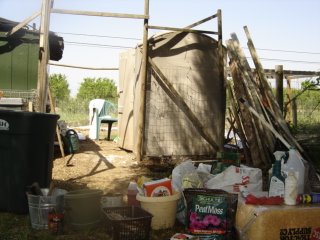
Pretty sad, huh?
But if nothing else I have, I do have visions of grandeur. My plans are for it to be full of life and beauty (and funky garden art all over the place).
I already have my veggies in their beds on the inside. It was the easiest garden I've put in yet. The soil was really loose once I broke through the crusty layer of chicken manure. Just a pitch fork to loosen it up, then broke it up a little more with the fork without really turning it. (I have plans for a blog on the Wonders of Germination when I get time.)
Had a bale of straw in the corner for a compost pile. Also had a bag of alfalfa meal which I like because it does all these wonderous things to the soil. Besides I like the way it smells, but then I like the way a horse barn smells too. Earthy.
I figured I'd just layer my veggie beds the way I was going to do the compost. Soil, a light dusting of alfalfa meal, coffee grounds, and lots of straw. Oh yeah, I watered it really well first.
When the soil had warmed up some (I used clear plastic for a couple of days) I just cleared a circle in the hay, dug a hole with a hand trowel, and filled it with water. Popped in the plants and added a little organic potting soil on top.
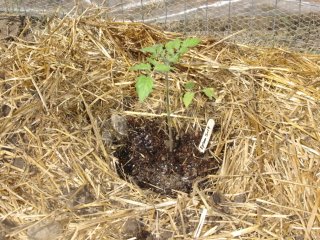
Next day I gave them a drink of fish emulsion. Something only a plant would love to drink, but we did have a dog (don't forget Rudy!) who practically devoured a container of fish emulsion that I'd left sitting on a rock. But dogs will eat pretty wierd stuff.
The plants look pretty good so far except the eggplant and lemon basil which appeared every morning with more holes in the leaves.
For some reason I diagnosed it as a flea beetle problem (holes are similar) and tried to come up with a creative, organic way to keep them at bay.
I wanted to find a way to protect the plants without trapping any pests inside. And I didn't like floating row covers 'cause when I tried them I couldn't see my plants or tell if they needed me.I take a very conservative approach to pest and weed control. This is my 'meeting with nature halfway' I guess.
Anyway to keep from making this too long, I found something at the Dollar Store that I could set over each plant on the theory that the pesky fly-ins would be so confused/repelled or maybe laughing so hard that they'd go elsewhere.
It's a plastic-covered wire waste basket. Looks like a lousy waste basket but I thought I'd found the perfection solution for flea beetles until it dawned on me that my problem was really EARWIGS! and this would never keep out an earwig.
Earwigs love brand new tender leaves and I've had them devour so many plants I must have a mental block against them. That's why I'm writing this all down...so maybe next year I'll be forewarned.
Cut up hoses and rolled up newspaper don't work for me...there's just too many of them and they have much more interesting places to hide) So I put some DE in a little fairy ring around some plants; with others I'm trying another experiment. (I'm trying to think like an earwig here.)
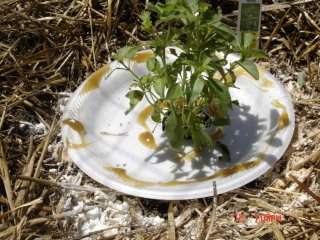 I made a styrofoam plate 'collar' and put Tanglefoot Pest Barrier around the inner and outer edges. Don't see how they could get past this one. It's not aesthetically pleasing, but then neither in Holy Basil. (I promise I won't post a photo of dead earwigs stuck to the plate!)
I made a styrofoam plate 'collar' and put Tanglefoot Pest Barrier around the inner and outer edges. Don't see how they could get past this one. It's not aesthetically pleasing, but then neither in Holy Basil. (I promise I won't post a photo of dead earwigs stuck to the plate!)
Next project: outside permeter of the coop which includes a Mr. Lincoln rose bush (heavenly smelling!) and the old min-hen house.
Wednesday, May 10, 2006
The Quality of Light
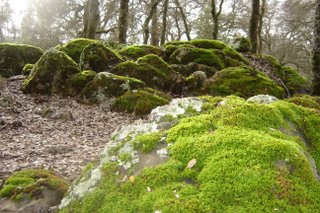
- planting a sun-loving herb on one side needed to block or filter the sun.
- added some garden art objects to shade a section.
- moved a big potted plant around to shade and cool off an more delicate plant.
- large rocks
- a trellis.
Monday, May 8, 2006
Visions and Hedgerows
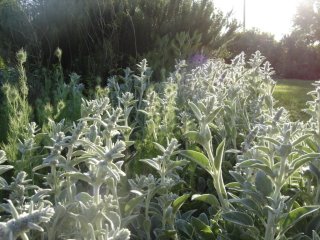
Gardening comes from our visions of beauty. Imagination is a prerequisite of the gardener.
When we moved to our property 16 year ago, it was 2 1/2 acres of neglect and bad plantings. The 32 walnut trees hadn't seen a pruning at least 10 years. There were bushes and hedgerows of wild plums, pittosporum, oleander, grapevines, wisteria....all crying out for attention. I had no experience with gardening on this scale.
One acre of this property had been a railroad easement in its previous life. The tracks were long gone, but it was hilled up along the road from the 16 tons of rock bed put in place to support a locomotive on the move.
At the time we bought it, the only thing it was supporting was an acre of prickly star thistle and other noxious weeds.
Our house sits at the back of the property so this was the view out our front door. Not a pretty sight. I remember looking longingly out of our front door and imagining something better, but it wasn't until we'd been here for about 5 years that I managed to do anything beyond wistful imaginings. My visions had to remain dormant since our house also faced the same neglect as the yard.
Then one day I began to scratch out a small rectangle in the dirt on the railroad easement and try my hand at a vegetable garden. I might as well have been gardening in some third world country. Hard clay, rock, weeds, infertile soil, dry heat. When I finally stirred it all up and added water, it was an invitation to a whole host of weeds and insects that had lain dormant too.
Maybe weeds and insects have their own visions?
Everything feasted on my plants....and thus my experiment with the balance of nature began. I began reading.
Mainly what I remember learning is that the environment around the garden is as crucial to its health as what is actually in the garden. What I had around my garden was bare dirt, open to the wind and sun. The insect world around us was having a virtual field day.
First learned lesson: insects get to your plants from:
- crawling up out of the soil, or
- flying in from your neighbors.
The British have a great solution for the 'flying in from your neighbors' problem. Hedgerows.
While most people probably think of hedgerows for privacy or windbreak, they are extremely beneficial for preventing pesky insects that fly in. Seems like they can't figure out how to fly over your bushes.
So I set about trying to create a hedgerow that would not only protect my plants, but provide privacy from the road which runs in front of our house. It's not a 'quick fix' solution. But a fence was out of the question: too expensive.
My cheapest solution was transplanting and I had lots of pittosporum (mock orange) here and began transplanting it out along the road. I also thought that upright rosemary would do well here and bought about 6 one-gallon plants, along with 5 beautiful climbing-type roses with deep red flowers.
Here is what it lo
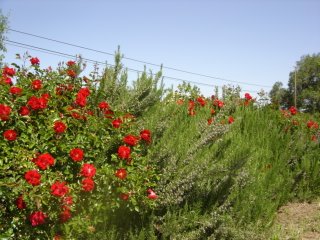 oks like 10 years later. I am definitely pleased by how it turned out. The pittosporum is actually another row right behind it, so we have a double hedgerow now. It's taken longer than I thought, but I realize the value of just going ahead and doing something....then waiting to see how it comes out.
oks like 10 years later. I am definitely pleased by how it turned out. The pittosporum is actually another row right behind it, so we have a double hedgerow now. It's taken longer than I thought, but I realize the value of just going ahead and doing something....then waiting to see how it comes out.Left photo: Roses and rosemary hedgerow
Top photo: a hedgerow of rosemary with lamb's ears, a little love-in-a-mist, some yarrow and a pomegranite tree a neighbor gave us.
This blog is dedicated to all of our visions of beauty.
Fat-free gardening
 Our extended California winter found me gazing longingly out at the rain-soaked yard. More and more weeks of non-gardening passed while I dug out and read my old garden books, updated our solar website, got our taxes done, joined a Garden Forum, and forwarded emails of cute dogs, jokes, etc.
Our extended California winter found me gazing longingly out at the rain-soaked yard. More and more weeks of non-gardening passed while I dug out and read my old garden books, updated our solar website, got our taxes done, joined a Garden Forum, and forwarded emails of cute dogs, jokes, etc.In the meantime I was watching the bathroom scales climb steadily upwards from this sedentary lifestyle.
I tried giving up favorite delicacies; half & half, French bread, apple pie, dark chocolate. Yumm. But this kind of deprivation wasn't working; then again neither was eating.
Joined Weight Watchers for a couple of weeks and found a good cookbook and a lot of hungry women. Decided I could try to live with Fat-free everything if that would help. Our frig is now full of FF milk, yogurt, sour cream. Husband won't touch the stuff. The only thing I can share with my Atkins friends is chicken breast and salad.
Dug out an old exercise video: Power Walking combined with aerobics and way-too-cheery sweet young things. Lost 5 lbs. but I'd memorized every chatty, little comment in a week and had to turn the volume off just to keep Power Walking.
A week with the grandkids in MI. Upon returning to CA. we were greeted by a frantically outrageous spring. Everything bloomed at once. Including the weeds. We came back to 4' high grass and weeds.... all 2 1/2 acres.
My husband and I gassed up the lawnmower and took turns slowly plowing through the our own personal veldt. Where the lawnmower couldn't go, I tackled borders and fence lines with rubberized gloved hands and began pulling. And digging. And hauling out wheelbarrows full of foxtail.
Working 3-5 hours a day, I felt like some cartoon charicature of a 'mad gardener. I pushed myself beyond my limitations. Never would I spend this much time on the treadmill or with my power walking video-friends.
 At night I fell into bed 3 hours early and arose the next day to tackle another micro-garden. In about 10 days I sweated off another 5 lbs. If I keep this up, maybe I can shed a few more pounds. If not, well I have a great view out my front window now.
At night I fell into bed 3 hours early and arose the next day to tackle another micro-garden. In about 10 days I sweated off another 5 lbs. If I keep this up, maybe I can shed a few more pounds. If not, well I have a great view out my front window now.Nice group of GardenBloggers:
http://voices.gardenweb.com/
